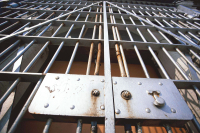Federal agencies long ignored needed repairs
The federal government has long been aware of run down buildings at the Oconaluftee Job Corps Center but failed to provide the center with funds to fix the problems, according to multiple reports, inspections and annual assessments conducted by the government.
Many observers are asking ‘why now?’ when these chronic problems have persisted for years. Esther Johnson, the national director of Job Corps since last year, said she is taking the problems more seriously than the agency apparently had in the past.
“That was my reaction,” Johnson said, when asked why the problems weren’t fixed sooner. “Why are we not taking care of some of these Job Corps Centers? It is unfortunate we are at this point with something that should have been rectified years ago.”
There are 122 Job Corps Centers nationwide managed by the Department of Labor. At most sites, private companies are contracted to run and staff the daily operations. The Oconalfutee Center is a bit different, however. The National Park Service is contracted to run the site since it is located inside the Great Smoky Mountains National Park.
That makes two federal agencies — both the Department of Labor and the National Park Service — responsible for what occurs at the site. Both are currently blaming the other for the problems, however.
Related Items
“I think this center could be a model center under a new operator,” Johnson said last week, insinuating the National Park Service was not doing a good job overseeing the center.
Two independent evaluations of the center by the Office of the Inspector General in the past year found fault with both agencies for failing to get the problems corrected.
The first report was conducted by the Inspector General in summer of 2006. The title of the report was “National Park Service has not assured the safety and health of students and staff at the Oconaluftee Job Corps Center.”
The two top issues were lack of functioning fire alarms in numerous buildings and deterioration of the cafeteria due to long-term water damage. Despite the report’s title, the Inspector General pinned some responsibility on the Department of Labor as well.
“We recommend you take immediate action to ensure conditions on center property are corrected,” the report stated in a letter addressed to Johnson.
It didn’t happen, however. The exact same problems were cited six months later in a follow-up audit by the Inspector General’s office in January.
The park service, which got $5 million last year from the Department of Labor to manage the Job Corps site, in turn subcontracts with other outfits to staff the center, primarily the Cherokee Boys Club. The Inspector General’s report credited local staff at the Job Corps Center with trying to get the attention of higher-ups in both the Park Service and Department of Labor to fix the problems over the years.
“Center personnel had requested the Regional Office to help them obtain the funding needed to make the needed repairs to the facility that would correct the severe conditions,” the Inspector General report stated.
Fire alarms
Staff at the center had periodically documented problems with fire alarms. A fire drill conducted by the center in May of 2006 apparently caught some attention when the center reported that fire alarms were either faulty or non-existent in the gym, a classroom building, a dorm and the carpentry shop.
The Department of Labor sent its own inspector to the site the following week who found the lack of fire alarms were in violation of safety codes with “potentially catastrophic effects.” Two weeks later, the National Park Service sent an inspector of their own to the site who made the same findings. But apparently nothing was done.
Documentation of the faulty fire alarms appeared as early as 2002 in an annual facility report provided to the Department of Labor. The on-site safety officer at the center had reported the faulty fire alarms to officials at both Job Corps and the National Park Service for several years, according to the Inspector General’s report.
In July 2006, the Inspector General gave the National Park Service 30 days to fix or install new fire alarms in the necessary buildings. In a response to the report, Johnson blamed the National Park Service for the problems. Johnson stated that Job Corps had made numerous attempts to remedy the problems, but management of the center “repeatedly failed to take the appropriate action in correcting serious life safety violations in a timely manner.”
Hopefully, the Inspector General’s report would spur the Park Service to fix the problems, Johnson wrote in her letter.
“If not, more serious consequences must result in order to protect the health and safety of students,” Johnson wrote.
Johnson stated that the Park Service had been given money to fix the fire alarms and her agency would see that the work was completed.
It’s unclear how much the Department of Labor really forked over for the fire alarms, however. According to a follow-up report by the Inspector General in January, the National Park Service was using left over funds from a previous year — technically intended for other things at the center — to cover the cost of the fire alarms.
Regardless, fire alarms still weren’t fixed six months later when the Inspector General conducted a follow-up report. Ironically, as the center was getting shut down last week, the fire alarms were finally being installed.
Cafeteria roof
Dining hall health concerns stemming from a chronic leaking roof were also cited in the Inspector General’s initial report in July 2006.
“We witnessed deteriorated conditions throughout the dining hall, such as exhaust fans partially out of the ceilings, water stains in the light fixtures, a crack in the ceiling of the food freezer and rust along the freezer ceiling, and walls flaking in a number of areas in the food preparation area, dining area and restroom area,” the report stated.
Once again, however, these conditions came as no surprise to the Department of Labor and National Park Service. The same concerns had cropped up in various reports and assessments of the facility for years — including mold in the cafeteria walls — without corrective action.
The Inspector General’s report in July 2006 recommended that the National Park Service have repairs to the dining hall roof underway within 30 days. As with the fire alarms, Johnson blamed the Park Service.
“While funding was provided several years ago to correct this problem, which was not nearly as severe as it is today, the work was never completed,” Johnson wrote.
Johnson told the Inspector General that Job Corps would give the Park Service more money to cover the roof repairs. The park service received $41,000, but it wasn’t enough.
“Those funds were used to provide temporary solutions to the problem,” according to a second report by the Inspector General in January.
The true cost of fixing the roof was estimated at $140,000 by the Department of Labor’s own assessment — three times more than what the Department of Labor gave the Park Service for the work.
It wasn’t the first time the Department of Labor provided only part of the money needed. In 1994, the Park Service was given $34,000 to fix the roof.
It wasn’t enough for the whole job, according to the Inspector General’s assessment of the 1994 repair attempt.
“The condition of the roof therefore continued to deteriorate until more severe damage was done to the interior of the building,” the Inspector General’s report stated.
Final straw
A follow-up report by the Inspector General in January placed blame with both the Department of Labor for failing to provide adeand the Park Service for not delivering.
“We do not believe that Job Corps has provided the needed emphasis that this condition requires in order to ensure the facility would not be a health danger to the students and staff,” the January report states. The report recommended that Job Corps develop a plan immediately to address the concerns.
Dueling reports over the past year debated whether the cafeteria needed to be closed. A National Park Service health inspector apparently visited the site and decided the cafeteria might have to be closed due to health concerns, and stated as much in a report. A Department of Labor inspector countered that claim, telling investigators from the Inspector General’s office that conditions “were not so severe that closure of the building would be called for at this time.”
The Department of Labor apparently changed its mind.
Michell Hicks, chief of the Eastern Band of Cherokee Indians, said the 70 local employees shouldn’t lose their jobs while two federal agencies hash out who should have done what when.
“Obviously we are receiving the brunt of it,” Hicks said.









